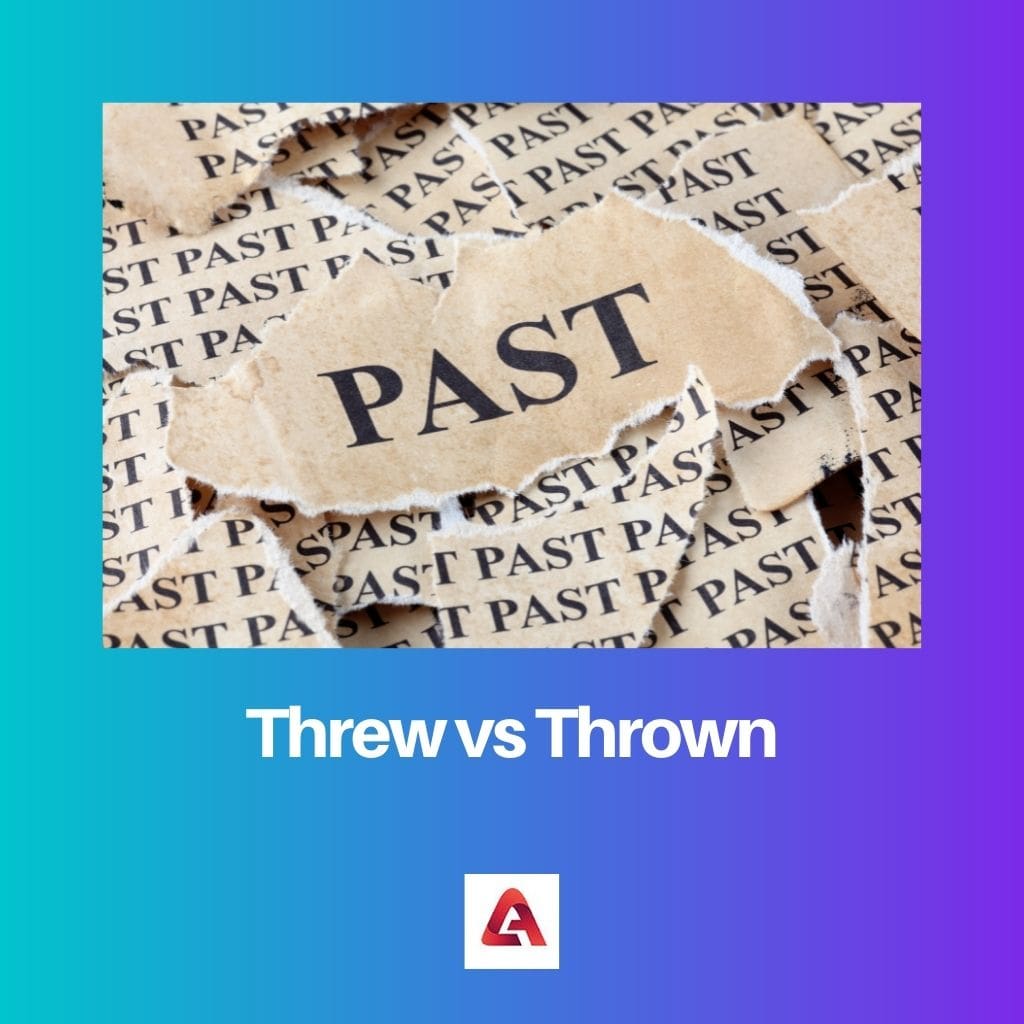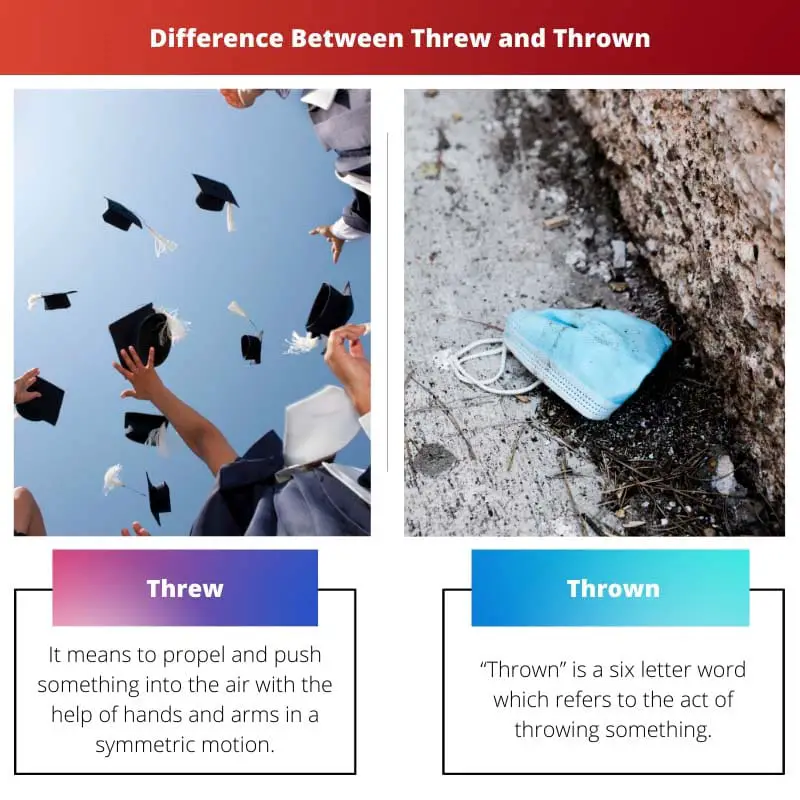Tenses are an important part of English grammar. They play an essential role in describing the reference of time concerning the moment of speaking.
The tense denotes when the action has taken place.
“Throw” can be used as a verb and a noun. The verb “Throw” means to propel anything into the air with an exerted force, with the help of hands and arms.
The meaning of noun form is used to describe the act of throwing something. It is also used in several standard forms to describe the furniture cover, etc.
Key Takeaways
- “Threw” is the simple past tense of the verb “throw,” which means to propel something through the air, while “thrown” is the past participle form of the same verb.
- “Threw” describes a completed action in the past, while “thrown” is used with auxiliary verbs to form perfect tenses.
- Both “threw” and “thrown” belong to the irregular verb group and do not follow the standard “-ed” pattern for past tense and past participle forms.
Threw vs Thrown
“Threw” describes an action that took place in the past, indicating that the subject performed the action of throwing something at a specific time in the past. “Thrown” describes the completed action of throwing something that has already happened, used in past perfect constructions.

Comparison Table
| Parameter of Comparison | Threw | Thrown |
|---|---|---|
| Number of letters | There are five letters in the word “Threw.” | The word “Thrown” consists of six letters |
| Grammar Form | It is used in the sentence as a past tense | It is used in the ruling as a past participle |
| Pronunciation | It is pronounced with the/ew/ sound at the end | It is pronounced with the/ow/ sound at the end |
| Rules of use | It can be used alone in a sentence as a past-tense verb | It cannot be used alone in the sentence and is used along with an auxiliary verb |
| Example | “John threw the ball on the floor.” | “The ball was thrown into the dustbin.” |
When to Use Threw?
“Threw” is a five-letter word which means to propel and push something into the air with the help of hands and arms in a symmetric motion. It is the past tense of the word “Throw”.
Often people get confused between the words “Threw” and “Through”, pronounced in a similar rhythm but an entirely different words. One has to be careful while using both these words in the same sentence, as the meaning of both words is different.
The word “Threw” can be used as a stand-alone verb in a sentence, and the following examples shall be considered to understand the application and usage of the word “Threw”.
- “He threw the pen and went inside”.
- “The strong wind threw her off, and she lost her balance”.
- “The toddler threw tantrums in the shop as his mother denied him chocolates”.
- “The students threw their hats in the air and jumped joyfully on their convocation”.
- “The dog wagged its tail in happiness when we threw some biscuits on the road”.
There are also a variety of contexts where the word “Threw” can be used. For instance, the following examples of using “Threw” in a different context can be understood as follows.
- “The food got spoilt, and she threw up after eating it”. Here “Threw up” refers to vomiting the food.
- “She threw over her first child as it was a girl”. Here “Threw over” refers to abandoning the child.
- “They threw him out of the college for his unlawful activities”. Here “Threw” refers to expelling him out of the college.

When to Use Thrown?
“Thrown” is a six-letter word which refers to throwing something. It is the past participle of the word “Throw”.
There are specific ways in which this word can be used in English Grammar.
The word “Thrown” is used along with an auxiliary verb such as Have, Has or Had to make past perfect tense. The past participle is also used to modify or change nouns and pronouns.
In some instances, people may get confused between the words “Thrown” and “Throne” as they both have a similar pronunciation and rhythm but have contrasting meanings and are unrelated to each other.
The following examples shall be considered to understand the application and usage of the word “Thrown”.
- “Several people were thrown out of the bus in a major accident”.
- “The contest has been thrown open to all the shoppers in the mall”.
- “Her father’s untimely death has thrown her family into total despair”.
- “The thief was caught red-handed and was immediately thrown into the prison”.
- “She was thrown aback by the surprise of seeing her brother return from abroad”.

Main Differences Between Threw and Thrown
- Both the words “Threw” and “Thrown” have a similar meaning in English but differ in their usage in a sentence. The main difference between the words “Threw” and “Thrown” is the tense form and the context in which it is used.
- “Threw” can be used alone as a verb in a sentence, whereas “Thrown” cannot be used alone and needs an auxiliary verb.
- The pronunciation of “Threw” has the/ew/ sound at the end and is different from “Thrown”, where the/ow/ sound is used at the end.
- The word “threw” has five letters, whereas “Thrown” has six letters.
- “Threw” is a past tense verb, but “Thrown” is a verb, not a tense.


The post provides a comprehensive analysis of the usage of ‘threw’ and ‘thrown’. Well articulated and informative.
This article is very insightful and helpful. The examples provided with ‘threw’ and ‘thrown’ are very helpful in understanding their use.
I appreciate the article’s clear explanation of when to use ‘threw’ and ‘thrown’ in different contexts. This certainly adds clarity to my understanding.
I really enjoy the witty comparison table. Clever way to present the differences between ‘threw’ and ‘thrown’.
This is such an important topic and your detailed explanation gives a good understanding of tense in English grammar.
I’m sorry to say this post is so boring, I almost threw up. It’s been thrown at us a lot of times already.
I found the explanation of the word ‘thrown’ to be helpful and informative. Great examples provided to illustrate its use.
Great explanation about tense and its use in English Grammar. Really interesting and insightful.
I agree. This article provides a clear explanation about the difference between ‘threw’ and ‘thrown’ and their uses.
This article was informative and useful. It’s helpful to understand ‘threw’ as past tense and ‘thrown’ as past participle.
It’s incredible how complex English grammar can be. Your examples really help understand when to use ‘threw’ and ‘thrown’.